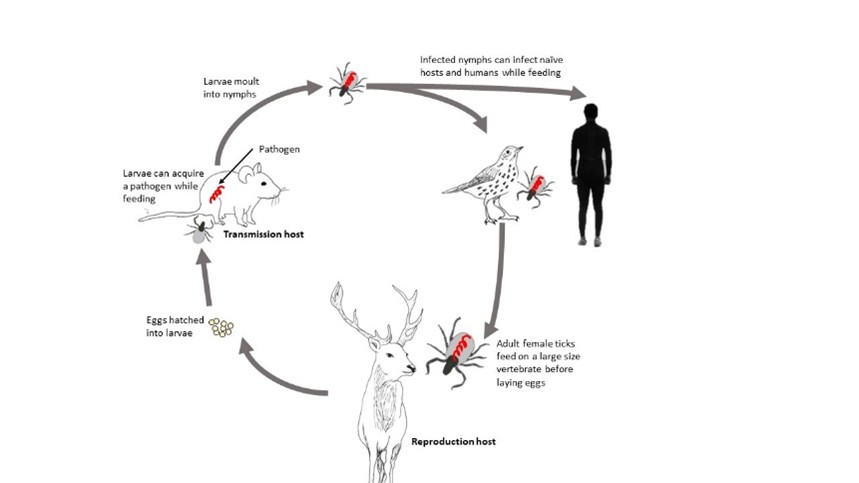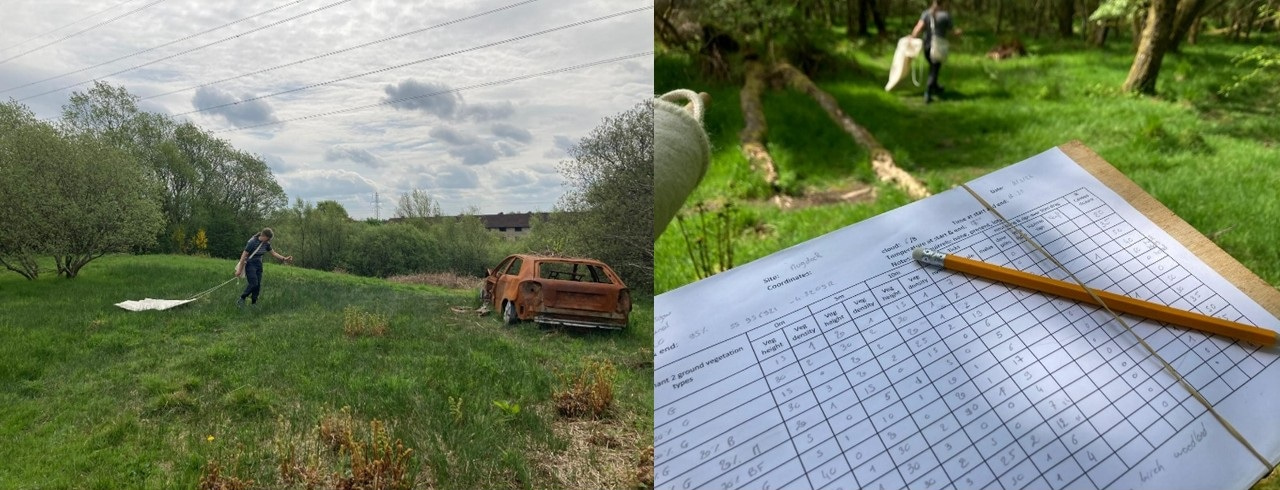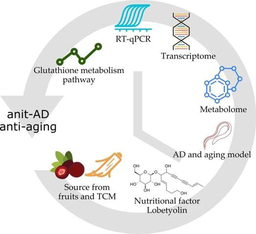
Lyme disease pathogens, transmitted through bites of infected ticks, are a growing threat, with disease incidence rising across the northern hemisphere. Ixodid ticks (hard-bodied ticks) have complex life cycles; After hatching, larvae take a blood meal from a host, attaching for a few days, before dropping into the leaf litter to digest their meal. They moult into nymphs, which will take another blood meal from a different host before dropping and moulting into adult ticks. Adult females will take one last blood meal before laying thousands of eggs, bringing a new generation.
Ticks face two main challenges: finding hosts and surviving off-hosts. Ixodes ricinus - the main vector of Lyme disease in Europe - is a generalist, feeding on most vertebrates, including humans and pets. Small and unable to move far, ticks climb vegetation and wait to attach onto passing animals. Larvae hatch uninfected, potentially acquiring Lyme disease bacteria during their first meal. In Europe, birds, rodents and other small-to-medium sized vertebrates (especially blackbirds, song thrushes, pheasants, squirrels and other rodents) can transmit the pathogens. Deer are interesting because they cannot transmit the pathogens to ticks, but are very important because they can feed a large numbers of larval, nymphal and adult ticks, and are often the main drivers of tick populations.

Rising Lyme disease incidence is likely driven by many factors, including increases in deer populations; climate warming that allows tick distributions to shift to higher latitudes and altitudes; reforestation that creates suitable habitats for ticks and their hosts; increased outdoor recreation; and greater awareness and reporting.
Now, stop reading for a minute and imagine you are hiking in the countryside. Chances are that, once home, you will check yourself for ticks, using a tick removal tool to dislodge any that have attached, watching out for Lyme disease symptoms for the next few weeks. Now imagine you are taking your dog for its morning walk in your local urban park before heading to work. It’s a nice park and you even see deer sometimes, hiding in the pockets of woodland. When you arrive back home, chances are, you are probably not going to check yourself for ticks before heading to work.
But maybe you should, depending on where you live. Ticks are present in many urban greenspaces throughout the northern hemisphere. Not every city or every park will have them, but research has shown that ticks do occur in many cities. From personal experience, we knew that tick hazard varies between cities. Therefore, we were particularly interested in why some cities vary so much in their tick and Lyme disease risks. What is it about the city itself? Perhaps cities with more trees have higher densities of ticks in their parks? Or is it more to do with where the city lies in the landscape? For example, if a city is surrounded by woodlands, a habitat known to be preferred by deer, other wildlife and ticks, do some of these animals visit or migrate into the city, carrying ticks and dropping them off in the urban parks? Do more green corridors between the city and its hinterland make it easier for animals to access the city, meaning a higher risk of ticks and Lyme disease for city dwellers?
In our Nature Cities study, we addressed these questions by taking a nation-wide approach, and selected 16 small cities in England, Wales and Scotland, chosen specifically to gain a wide variation in woodland cover both inside and surrounding each city. In and around each city, we selected 5 urban greenspaces & 5 rural woodlands (5 - 10 km away from the cities) and we estimated the density of questing (unfed ticks that are looking for hosts) ticks at each site before testing them for the bacteria causing Lyme disease.

Surveying for ticks by dragging a blanket in an urban park (left) and rural woodland (right) in the central belt, Scotland. Picture: Sara Gandy
We expected that greener cities with more woodlands and less built-up areas (within 5 km of the city centre) would have more ticks, as woodlands are the most suitable habitats for Ixodes ricinus, providing them with a suitable microclimate for their survival off host and harbouring higher densities of vertebrate hosts. However, we were surprised that this was not the case at all: woodland cover within the city did not relate to the density of ticks or the Lyme disease risk (density of infected ticks) in urban greenspaces. We also found that connectivity between cities and their hinterlands did not affected tick or Lyme disease risk, probably because most our cities were connected enough.
Instead, we found that what is happening in the surrounding rural environment matters much more strongly; the density of ticks (including infected ticks) in cities depended on the density of ticks in the hinterland; the more ticks in the hinterland, the more ticks and infected ticks in the city. We also found significantly more ticks in urban greenspaces in cities that had more woodland cover and less built-up cover in their hinterlands, (5 to 10 kilometres away from the city itself).
Why is that? We hypothesise that hinterlands with more woodlands and less built-up areas are also likely to have more deer, which could be dispersing into the cities, carrying ticks with them. Another explanation could be that, with cities growing larger, some rural woodlands may become new urban greenspaces, retaining ticks and their hosts.
Our key finding, that the hinterlands’ characteristics (tick density, woodland cover, built-up cover), rather than within-city metrics, influence urban ticks and Lyme disease hazard, shows that rural and urban ecosystem are strongly linked. Based on these findings, we believe that mitigation strategies might be more effective if they target both the individual urban greenspaces and key rural woodlands.
Follow the Topic
-
Nature Cities

This journal aims to deepen and integrate basic and applied understanding of the character and dynamics of cities, including their roles, impacts and influences — past, present and future.



Please sign in or register for FREE
If you are a registered user on Research Communities by Springer Nature, please sign in